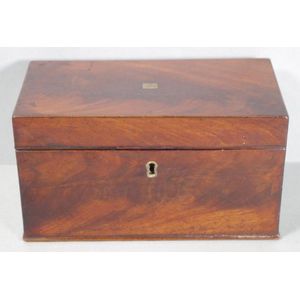Victorian Mahogany Writing Box with Mother-of-Pearl Embellishments
You must be a subscriber, and be logged in to view price and dealer details.
Subscribe Now to view actual auction price for this item
When you subscribe, you have the option of setting the currency in which to display prices to $Au, $US, $NZ or Stg.
- Mahogany - Mahogany is a dense, close grained red-coloured timber from the West Indies and Central America. It was first imported into Europe in the the early 18th century and its use continued through the 19th century. It was popular for furniture making because of its strength, the wide boards available, the distinctive grain on some boards, termed flame mahogany and the rich warm colour of the timber when it was polished.. The "flame" was produced where a limb grew out from the trunk of the tree, and this timber was usually sliced into veneers for feature panels on doors, backs and cornices.
Some terms used to describe mahogany relate to the country from which it originally came, such as "Cuban" mahogany, "Honduras" mahogany etc. However unless the wood has been tested the names assigned are more a selling feature, rather than a true indication of the timber's origin. - Victorian Period - The Victorian period of furniture and decorative arts design covers the reign of Queen Victoria from 1837 to 1901. There was not one dominant style of furniture in the Victorian period. Designers used and modified many historical styles such as Gothic, Tudor, Elizabethan, English Rococo, Neoclassical and others, although use of some styles, such as English Rococo and Gothic tended to dominate the furniture manufacture of the period.
The Victorian period was preceded by the Regency and William IV periods, and followed by the Edwardian period, named for Edward VII (1841 ? 1910) who was King of the United Kingdom and the British Dominions and Emperor of India for the brief period from 1901 until his death in 1910. - Mother-Of-Pearl - Mother-of-pearl, technical name "nacre", is the inner layer of a sea shell. The iridescent colours and strength of this material were widely used in the nineteenth century as an inlay in jewellery, furniture, (especially papier mache furniture) and musical instruments.
In the early 1900s it was used to make pearl buttons. Mother-of-pearl is a soft material that is easily cut or engraved.
Nowadays it is a by-product of the oyster, freshwater pearl mussel and abalone industries.
This item has been included into following indexes:
Visually similar items

A Victorian rosewood writing box, 19th century, the rectangular box with a mother-of-pearl cartouche to the lid and a matching escutcheon, with white metal stringing and paper lined to the interior. Height 14 cm. Width 35.5 cm. Depth 24 cm

A rosewood sewing box, 19th century, of rectangular form with cross banded edges in walnut, a plain shield plaque to lid, opening to a removable partitioned tray with compartments for sewing accoutrements, vintage sewing items enclosed. Height 14 cm. Lengt

A Georgian mahogany & brass bound, campaign writing slope c.1820's with tooled leather locking writing insert, lockable lower side drawer, secret drawers, compartments for stationery, writing accessories and ink bottles, height 22 cm. Width 53 cm. Depth 29

George III flame mahogany tea caddy, rectangular form, twin box interior with inlaid & sliding lids, c1800, 23 cm x 12 cm, 12.5 cm high
